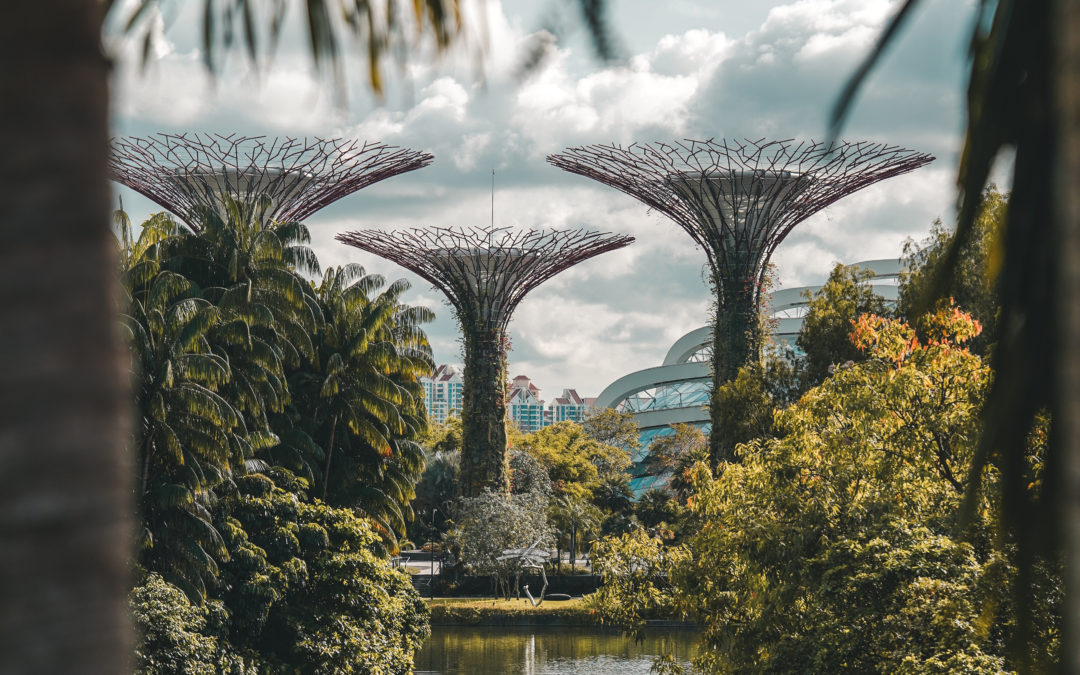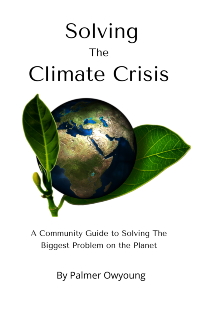6 Reasons to Be Hopeful About Climate Change
Climate change is the biggest challenge facing humanity today, but it is not a hopeless one. Globally there are already a lot of solutions that are being implemented by governments, businesses and individuals. And new ones are being created by entrepreneurs every day that will put us on the road to sustainability.
Today we are on the path to 3 C warming by the end of the century. But just a decade ago we were headed toward 5 C or more. So, while we are still in trouble, changes are occurring that you may not be aware of. So, here are six reasons to be hopeful about climate change.
Artificial Intelligence– Yes there has been a lot written about AI since the release of Chat GPT. Experts have discussed how AI could become a threat to humans if it goes rogue and decides to kill us.
However, for the moment, the greater threat than an automated kill us, is humans using it in an abusive manner, to create detailed fake news and more elaborate scams. Then there is also the very real threat that AI will continue to concentrate wealth and power into the hands of the search, social media, and other tech giants that are building it. You can read more about that here
If used in the right way AI is one of the most powerful tools that we have for mitigating climate change, understanding nature, and preventing greater loss of biodiversity.
AI can be used to analyze large amounts of data, find patterns and insights, optimize processes and systems, and generate new ideas and innovations. For example, it is already being used to analyze satellite data to create better climate models, that can give us more accurate predictions about what is going to happen in the future, which can inform better decision-making and lead to better policies.
These models can also predict extreme weather events, such as fires, floods, and hurricanes so that we can adapt and prepare for them, which will save lives.
AI is also being used to build so-called smart grids, which is a network that integrates energy distribution and digital communication technology. This enables utility companies to optimize the generation, transmission, and distribution of electricity and reduce energy loss. According to a 2022 report from the Boston Consulting Group, both governments and the private sector see AI as an essential tool for fighting climate change. The report went on to predict that by 2030 the technology could reduce global GHG emissions by as much as 5% to 10% or 2.6 to 5.3 gigatons of CO2 equivalent, by simply monitoring and predicting emissions and eliminating any inefficiencies.
An analysis by Accenture shows that adopting digital technologies across industries could deliver up to a 20% reduction in emissions by 2050. For example, IntenCity is a building made by Schneider Electric which it calls “The Building of the Future.” It is equipped with Internet of Things (IoT) sensors that capture more than 60,000 data points every 10 minutes. The building learns and adapts to its environment, making it more efficient.
The result is that IntenCity uses just 11% of the average consumption of a building in Europe. According to a report from the Global Alliance for Buildings and Construction, the construction and operation of buildings is responsible for 40% of the world’s CO2 emissions and according to the Environmental Protection Agency, 30% of that energy is wasted through inefficiency. So, buildings like Intencity, combined with AI can make an enormous difference in creating a sustainable future.
AI is also being used to monitor and protect biodiversity and ecosystems, by detecting changes in land use, deforestation, wildlife poaching, coral bleaching, and invasive species. It is also helping us to understand the “language,” that plants and mushrooms speak so that we can better understand when an ecosystem is in danger of collapse.
Artificial intelligence is helping us to develop low-carbon technologies such as biofuels, better batteries, and hydrogen, as well as next-generation solar and wind that is more efficient and cheaper to produce and can even generate electricity at night when there is no sun and there is very little wind.
2. Nature is resilient
Nature is more resilient than we thought and there is mounting evidence that some ecosystems are starting to adapt to climate change. If we remove the pressures of human development from nature it can repair itself. In some cases, we can use science to give it a boost to make things go faster.
The Great Barrier Reef
For example, the Great Barrier Reef has seen substantial damage from mass coral bleaching events and attacks from crown of thorns starfish over the past two decades. However, between August 2021 and May 2022, a survey of 87 reefs found that the average hard coral cover in the upper region and central areas increased by around one-third. That is the highest increase since the Australian Institute of Marine Science (AIMS) began monitoring it 36 years ago.
Although this doesn’t mean we are out of the woods yet, it does mean that coral reefs are capable of repairing themselves. If we assist them with a little help from science they can do so even quicker.
An organization named Reef Watch Marine Conservation is doing just this by zapping reefs with solar electrical currents which causes struggling reefs to self-repair. The technology can even be used to grow new reefs while growing up to 10 times faster than they naturally do.
At the King Abdullah University of Science and Technology in Saudi Arabia, a Brazilian microbiologist named Raquel Peixoto is using probiotics to inoculate coral reefs. This can make them more resilient to environmental threats such as heat stress, pathogens, and oil spills. In the lab, the probiotics treatment increases coral survival rates by 40% and she has begun experiments in open water.
Since 2008 Mote Marine Laboratory in Florida has restored more than 200,000 corals by growing fragments in a lab and then fusing them with existing damaged reefs. They also use techniques like “microfragmentation” and “skinning” in which dozens of thin fragments of corals are laid on top of a dead coral head until they fuse.
According to a review published in the journal Nature, global fishing is becoming more sustainable in some regions and the destruction of habitats such as seagrass meadows and mangroves is almost at a halt. In some places like Tampa Bay, Florida, and the Philippines, the habitats are being restored. According to the review, the ocean can repair itself and scientists estimate that with enough effort the oceans can fully recover by 2050, in just one generation.
However, nature’s ability to repair itself is not just limited to the ocean. According to a study published in Nature, restoring natural forests is the best way to remove atmospheric carbon, it says, “plantations are much poorer at storing carbon than are natural forests, which develop with little or no disturbance from humans.” The paper goes on to say that, “Natural-forest restoration is the most effective approach for storing carbon. But clashing priorities are sabotaging carbon storage potential.” Studies show that allowing forests to rewild on their own rather than planting trees, is not only faster, but it also creates healthier more biodiverse forests. This is good news because rewilding is much more scalable and cheaper than planting trees.
A 2019 study estimated that by restoring natural terrestrial carbon sinks, which include mangroves, peat bogs, forests, and the soil, we could sequester and store between 11–15 billion tons of CO2 per year. This means that our natural carbon sinks could sequester about 30% of the CO2 we emit every year. Meaning that we could remove a substantial part of our annual CO2 emissions, with no new technology, no fancy equipment, and no excessive costs. We just need to stop cutting down our forests and killing our soil and start repairing these natural carbon sinks by leaving them alone.
Even places that have been substantially damaged are showing remarkable resilience. In a four square kilometer exclusion zone around Chernobyl, which was hit by a nuclear disaster in 1986 and is now virtually void of human life, the flora and fauna are flourishing. Today wolves, moose, wild boars, bison, and fish, among others call the area home and are thriving, according to a 2023 study published in Food Webs.
3. New laws
One of the most effective ways to solve climate change is to enact laws and policies that limit greenhouse gas emissions, promote clean energy and transport, and protect and restore nature. Many countries, regions, cities, and businesses have committed to achieving net-zero emissions by 2050 or sooner, in line with the Paris Agreement goal of limiting global warming to well below 2°C. However, most of these countries are not on target to fulfilling their obligations. Nevertheless, there is reason for hope because of a few new laws.
Inflation Reduction Act
In August 2022 a $370 billion climate bill passed, making it the single largest American investment to slow global warming by reducing demand for fossil fuels. The bill invests money over 10 years in the form of tax credits that steer consumers toward electric vehicles and push utility companies toward renewable energy sources. Energy experts say that the bill could help to cut greenhouse gas emissions by 40% below 2005 levels, which puts the country in striking distance of meeting its goal of cutting emissions in half by 2030.
High Seas Treaty
In March of 2023, the High Seas Treaty was announced which aims to place 30% of the open ocean into protected areas by 2030, to protect marine life and allow it to recuperate. The agreement was approved after decades of talks, and this is the first international agreement on ocean protection since the UN Convention on the Law of the Sea was signed in 1982.
Nature Has Rights
In 2021 a lawsuit was filed against the State of Florida to protect five bodies of water against development. The basis of the argument was that nature deserves legal rights too. However, this is far from a unique situation and for years nature has been slowly gaining rights around the world.
For example, in November 2020 Orange County, Florida voters overwhelmingly approved an amendment recognizing four rights of nature: the right to exist, to flow, to be protected against pollution, and to maintain a healthy ecosystem. This decision received support from 89% of the county’s 1.4 million residents and is paired with the human right to have clean water.
In Trujillo, Peru, in 2014, Chicama the world’s longest wave, also became the first to be protected by law, which prohibits any construction within a 2km radius. Following this decision, more waves in Peru were legally protected.
In 2017, New Zealand granted the Whanganui River legal rights equivalent to those of a human being, after a years-long struggle by the Maori.
In 2008 Ecuador was the first country to recognize the Rights of Mother Earth. The law allows citizens to bring forth a lawsuit on behalf of nature. This ruling was later used successfully against a construction company that dumped rubble into a river, forcing the government to clean it up.
Today around 20 countries, including Canada, Colombia, India, Bolivia, and Uganda, as well as several Tribal Nations in the US and dozens of cities and counties, have some form of nature rights laws.
4. Businesses and Consumers are changing
Another reason to be hopeful about solving climate change is that many businesses and people are taking action and changing their behaviors to reduce their environmental impact. This is largely driven by consumer demand and the recognition that companies need to be more socially responsible.
B-Corporations
One of the main problems with corporations is that their primary concern is maximizing shareholder value, without regard for much else. This leads to rapacious behavior without concern for negative externalities. To change their behavior we need to change their legal charter so that in addition to profits, corporations also consider the people they affect, namely their customers and workers, as well as the environment. This is known as the “triple Ps” people, planet, and profit.
Fortunately, this legal charter already exists in the form of a benefit corporation also known as a B-Corporation. As of 2023 there are over 6,400 certified B-Corporations in 77 countries in 158 industries. Some of these include well-known brands like Ben & Jerry’s Ice Cream, Patagonia Clothing, and Stonyfield Organic Yogurt.
The B-Corporation was started in 2006 by a group of university friends to revolutionize capitalism and remake the global economy to benefit all people communities and the planet.
Companies that become B-Corporations are legally required to consider the impact of their actions on their workers, customers, suppliers, community, and the environment. The driving philosophy behind them is that businesses are to be used as a force for good, rather than just a means to increase shareholder value.
The steps to becoming a certified B-Corporation don’t just evaluate the product or service of a company but also assess its social and environmental performance. The process is quite rigorous and takes anywhere between 6 to 10 months to complete, with only 1 in 3 passing.
The assessment evaluates how a company’s operation and products or services affect the workers, community, environment, and customers that they transact with. The vetting process also looks at a company’s supply chain, which according to consulting company McKinsey can make up between 80% to 90% of a company’s carbon footprint.
The evaluation then looks at the company’s charitable giving and the employee benefits they offer. It is then given an overall impact score, which can be viewed on the B-Corporation website. The certification also requires the business to legally amend its’ governing charter to require its board of directors to balance profit, the environment, its employees, its customers, and the communities they serve. Thus a corporation would not only have to deal with the potential of financial bankruptcy but social and environmental bankruptcy as well.
This combination of third-party validation, public transparency, and legal accountability helps to build trust between corporations and the public. This goes far beyond the superficial and sometimes self-interested actions like Corporate Social Responsibility (CSR), which is often nothing more than greenwashing.
Right now choosing to become a B-Corporation is voluntary. However, in the future, it could be legally mandated for all corporations above a certain size to use B-corporations for their business charters.
Today corporate managers and their boards are legally obligated to grow the earnings of a company by their shareholders. This pressure for profits sometimes leads to poor decisions and negative externalities like pollution, habitat destruction, or human rights violations. However, if they were legally required to factor in social and environmental costs in their decision-making, corporations could make more rational decisions rather than ones strictly motivated by profit.
Consumers Are More Aware
In addition, consumers are more aware and a 2021 report from The Economist Intelligence Unit and the World Wildlife Foundation showed a 71% rise in online searches for sustainable goods globally, since 2016. This increased demand for sustainable goods is not just coming from wealthy countries either. According to the report, there was an increase in searches by 24% in Indonesia and 120% in Ecuador.
Consulting company Deloitte came to a similar conclusion. In a 2022 survey, they found that 40% of all UK consumers have chosen brands because they have sustainable practices or values.
As consumers become more aware and choose sustainability through their purchasing power, corporations will need to become more transparent and change their business practices. Businesses will no longer be able to just consider profits, but the impact they have on the planet and the people they serve as well.
In part 2 of 6 Reasons to Be Hopeful About Climate Change, we’ll look at how the exponential growth of renewable energy combined with next-generation technologies are changing how we produce electricity.



